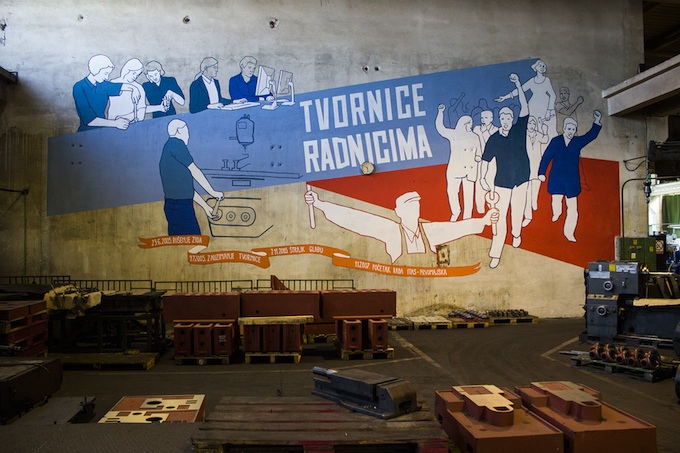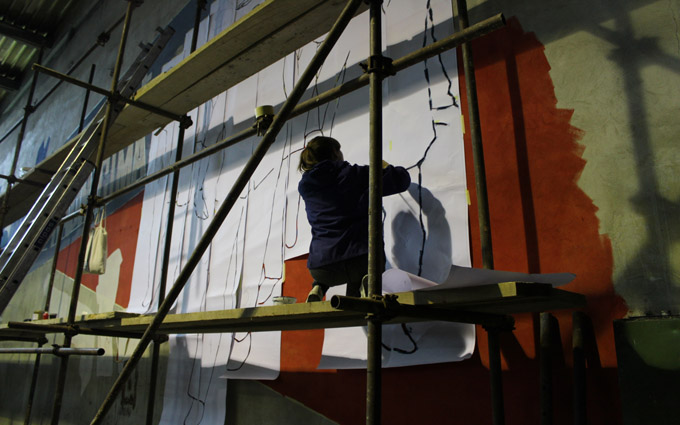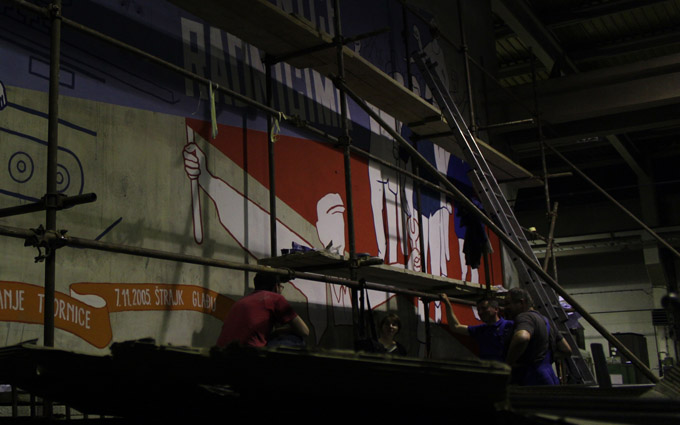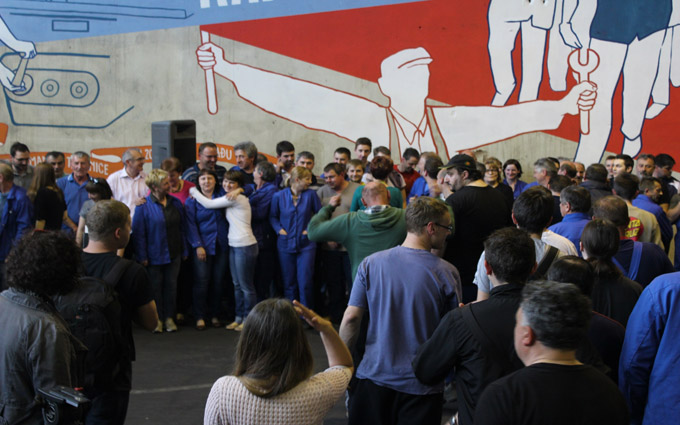
The finished mural. Photo documentation KURS.
On a recent trip to Serbia that I was able to take with the generous support of the Trust for Mutual Understanding, an organization that supports creative collaborative exchange with Russia and Central and Eastern Europe, I had a chance to meet with the artists Miloš Miletić and Mirjana Radovanović of the KURS Association. The group consists of young artists interested in cultural accessibility and the history and future of public space. One of their recent projects involved an interesting public space—a wall in a communally owned machine-tools factory in a small town in Croatia. The process of planning and creating the mural began when BLOK curators collective invited Miloš and Mirjana to take part in Urban Festival 13, a festival in Zagreb, Croatia focused on exploring the role of the public square in today’s cities. The mural was unveiled in May 2015 as part of the Factories Day celebration. In the following interview, the artists of the KURS Association discuss their creative process, historical influences, and the ways that collaborating with the factory workers shaped the outcome of their mural in surprising ways.
Creative Time Reports (Marisa Mazria Katz, editor): How did you connect your vision for this project with struggles that are affecting large swathes of the population?
KURS : From the moment we received the invitation to paint the mural as part of UrbanFestival 13, we started thinking about how it could reflect the current class struggle, in which different social groups (workers, student, migrants) are fighting to improve their working and living conditions. We wanted the mural to have a didactic function and not to serve simply as decoration and a mere aesthetization of some event.
CTR: Can you talk about the location chosen for the piece and why it was so significant in terms of your overall plan?
KURS : The BLOK curators suggested that we consider the ITAS-Prvomajska factory as a place that had importance for the entire region of the former Yugoslavia and one where our potential intervention could support the ongoing workers’ struggle. The factory is located in the small town of Ivanec, in northwestern Croatia. It was founded in 1961 as a craft workshop called ITAS, and the following year it became part of the Prvomajska machine factory in Zagreb. At that time Prvomajska was the sixth largest machine tools and equipment manufacturer in the world, employing 900 workersat its peak. The factory operated smoothly until 1999, when—like many factories in the former Yugoslavia—it found itself in the chaos of the “post-socialist” transition.

Mirjana, member of KURS, transferring the drawing of the people protesting. Photo documentation KURS.
CTR: How would you describe the transition, particularly in light of all of the chaos that ensued following these historic governmental shifts?
KURS : All the factories in Yugoslavia were socially owned, meaning the workers themselves managed the factories under a system called “self-management,” until the dissolution of Yugoslavia began. The disintegration of Yugoslavia (which began in 1991) marked the start of a devastating privatization process, which, under the pretext of transition from a socialist society to a capitalist one, led to a collapse of industrial production. From 2000 to 2005 the situation in the factory worsened: the ownership structure often changed;factory-owned infrastructure, land and other assets were put up for sale; and the workers’paychecks were delayed.
The increasingly bad state of affairs reached a critical point in 2005, when the factory owners attempted to divide the factory physically by building a wall in the middle of the hall. This was done so that the new owners could split the production processes, transferring one part to a newly formed sister company, which would enable them to extract additional capital from ITAS, fire workers more easily and sell the collectively owned property and machines. In response to this, the workers launched numerous strikes, set up roadblocks and engaged in hunger strikes in order to preserve their right to work and demand better conditions, and eventually they tore down the new wall. Even though it took one year of strikes and blockades, the workers created a new form of self-management in January 2007, which they proudly called the “self-management for the 21st century.”

Regular working day in ITAS. Photo documentation KURS.
CTR: How did they execute this form of “self-management?”
KURS : The workers managed to convert their claims for unpaid wages into stock and to effectively become majority owners of the factory. In doing so, they managed to save their jobs, but perhaps more importantly, their actions also served as a call for rethinking the workers’ self-management system. They demonstrated how continuous struggle can provide more stable jobs and incomes, providing a model for how workers’ self-management can function within a capitalist society. By taking over the factory and making it effective once again, ITAS workers put themselves in the center of the regional workers’ struggle.
CTR:What prompted you to place the mural at the site of the factory?
KURS : From the outset of the project we had challenge of how to contextualize the mural, since we faced a complex situation within the factory. Some 40 percent of the ITAS workforce is made up of young workers whose perceptions of the factory are different from those of the older workers, who have in some cases been there for more than 30 years. Unlike their older colleagues, the young workers, who generally got their jobs in the years after the factory was taken over by the workers, did not have any experience of the self-management system that was common in socialist Yugoslavia. This led us to ask ourselves, To whom does the mural refer and for whom is it intended? After considering these crucial questions, we decided to paint the mural on an interior wall of the factory hall, where it could be seen by the workers, motivating them to persevere in their struggle.
CTR: How were you able to address the various issues that the workers had been reckoning with?
KURS : We tried to outline two sides of the working class’s current situation in our initial sketch: the production process and the struggle for better working conditions. In the mural these two themes would be linked by a central slogan. When we visited ITAS, we spoke with Dragutin Varga, one of the former protest leaders, and noted that he often highlighted the fact that the “factory is defended from within.” We considered usingthis quotation as the central slogan, but after thinking about the function of the mural and the message that it should convey, we ultimately decided to use part of Marx’s slogan instead: “Factories to the workers, land to the peasants.” The central element of the mural was the figure of a worker spreading his hands and at the same time emulating the posture of Matija Gubec, the leader of the Croatian-Slovene peasant rebellion of 1573,as depicted in the monument commemorating the revolt. The figure of Gubec, a well-known symbol of class struggle in the area where the factory is located, helped the workers to identify with the mural. On the lower part of the composition we painted a ribbon containing the important dates of the ITAS workers’ struggle, which created a connection between current and past class clashes.

The workers in conversation with artists. Photo documentation KURS
CTR: What was the overall perception from the workers about the mural? What kinds of interactions did you encounter during your time there?
KURS : Painting the mural within the factory walls gave us the opportunity to share our working hours and space with the workers. Moreover, the wall on which we painted was located in the central part of the factory, where a large number of workers usually circulate, thus making it easier to communicate with them. Our conversations with the workers led to some minor changes in the sketch: apart from the slogan, we also changed the machines depicted in the mural, incorporating the one that is commonly used at ITAS. More important, these conversations also changed the way in which the workers perceived both us and the mural during those ten days of intensive work.
Initially they were skeptical about the slogan “Factories to the workers.” They were aware of the fact that most of the factories in the former Yugoslavia were destroyed during the process of “transition” from collective to private ownership and that nowadays many workers there have no factories to take over. Still they often commented that they were not satisfied with working conditions and their salaries, but they recognized that their position was more secure than that of workers in privatized factories. The most exceptional moment occurred at the very end of our work, when we finished the ribbon and saw that the gathered workers could fully identify with the composition on the wall. They were part of the struggle, remembering the moments when they were defending the factory and fighting for it, but they also started commenting on the free space left at the end of the ribbon, which signifies future struggles. ITAS is their factory, but there are factories that are yet to be taken over by other workers.
CTR: How did the process of painting the mural at the actual factory enhance the experience for the workers and for you?
KURS : By painting the mural at the ITAS-Prvomajska factory, we gave support to a workers’organization that fought against the logic of the market and the interests of big capital. With this intervention, we did not intend to romanticize the ITAS workers’ struggle but rather to become a part of it and to contribute actively to its diffusion and fortification. We decided to paint the mural within the factory because of our desire to speak to the workers by showing them a composition that puts the workers’ collective and self-management at the forefront and to send a clear message to all visitors: “ITAS is the workers.” Generally speaking, the mural in the ITAS-Prvomajska factory represents the necessity of developing progressive models of management by workers’ collectives. This class struggle is not being waged only in factories. It must flow into other spheres of society, as well as into the sphere of culture and art, which cannot build a sustainable material basis without industrial production and a rethinking of models of labor.

Workers gather in front of the mural. Photo by Matija Kralj.

